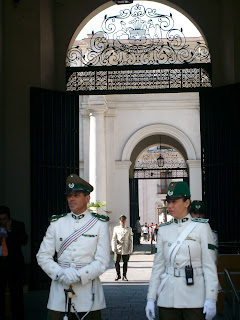Above: Atacama desert
On the Wednesday morning of November 26, I boarded another Cruz del Sur bus (a 6-hour ride) from Arequipa to Tacna (Peru's southernmost town bordering Chile) where I hitched a 'colectivo' taxi (for a 'gringo' price of 15 soles) to take me across the border to Chile. It was a new experience for me to share a taxi with 5 male strangers. We were silent throughout the 50+ minutes journey as we rode in the taxi and followed the process to cross the Peruvian and Chilean customs and immigration. The system (whether official or otherwise) was odd but it served a purpose and worked.The taxi driver dropped us at the bus station in Arica (Chile's northernmost town bordering Peru) where I bought a bus ticket (for 31,000 Chilean Pesos or ~US$48) for departure the same night to Santiago. The marathon 30-hour bus ride south from Arica to Santiago was the longest I have endured thus far. The Pullman bus stopped a few times at several small towns along the way to drop off and pick up passengers - all of which were a welcome respite from the otherwise very dull and solitude journey across the dry Atacama desert (presumably the driest desert in the world). At the stops, we were able to walk around a bit and buy some real food (versus the awful crackers and sugary pack drinks they served on board).
Above left: Sopa de marisco (seafood soup) from Arica - so good, it hit a spot
My first impression of the country and Chileans - immediately after crossing the Peruvian-Chilean border - was 1) Chile seemed more modern and developed than her northern neighbor with industries and trade to back her economy (unlike tourism-based Peru) and 2) Chileans in general (many of whom have white skin tone) seemed to place a high regard on their physical appearance - as if they feared a ridicule of a 'lower' status by others on the superficiality of their looks, or perhaps to distinguish themselves from the Peruvians.
Santiago - with her modern infrastructure of reliable transportation (the usual buses, taxis, and subway system), high-rise apartments, shopping centers, and office buildings, and a cultured lifestyle of museums, theaters and cafes - was definitely not your 'typical' South American city. It was a nice change of sort but I missed the energy of the Peruvian highlands. There was simply something special about (being around) mother nature that brought out the best in me. Still, I made the most of my stay in the city (that resembled the Spanish cities of Madrid and Barcelona) by indulging in lattes, visiting the library, and catching the latest Bond movie "Quantum of Solace" (which I thought was pretty good).
Above right: Sopa de Marisco again (3,500 Chilean Pesos or ~US$5.30)
Above right: The concept at Cafe Caribe (and a few others) in Chile: 'Hooters' meet 'Starbucks' (you get the drift)
Next post: Valparaiso, Concon y Viña del Mar, Chile
Previous post: Arequipa, Peru

































.JPG)





















